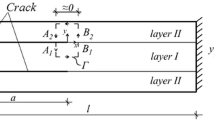The interfaces in multilayer composite structures are susceptible to delamination due to the combination of active tensile and shear loads under operating conditions. A four-layer center crack composite beam in four-point bending is simulated to determine the interfacial fracture energy of the multilayer structure. The crack is propagating along the interface between the second and third layers. Based on the Euler–Bernoulli theory, the strain energy of the four-layer composite beam is derived. Strain energies before and after the propagation of the interfacial crack are calculated, which results in determining strain energy release rates. Analytical results for those rates are validated with the numerical data obtained by the finite element method. The effect of layer thickness of the composite beam on the interfacial fracture toughness is investigated through a parametric study.





Similar content being viewed by others
References
A. T. Seyhan, M. Tanoglu, and K. Schulte, “Mode I and mode II fracture toughness of E-glass non-crimp fabric/carbon nanotube (CNT) modified polymer based composites,” Eng. Fract. Mech., 75, 5151–5162 (2008).
J. J. Lee, J. O. Lim, and J. S. Huh, “Mode II interlaminar fracture behavior of carbon bead-filled epoxy/glass fiber hybrid composite,” Polym. Compos., 21, 343–352 (2000).
X. K. Zhu and J. A. Joyce, “Review of fracture toughness (G, K, J, CTOD, CTOA) testing and standardization,” Eng. Fract. Mech., 85, 1–46 (2012).
A. B. Pereira and A. B. de Morais, “Mode II interlaminar fracture of glass/epoxy multidirectional laminates,” Composites: Part A, 35, 265–272 (2004).
L. A. Carlsson, J. W. Gillespie, Jr, and R. B. Pipes, “On the analysis and design of the end notched flexure (ENF) specimen for mode II testing,” J. Compos. Mater., 20, 594–604 (1986).
H. Wang and T. Vu-Khanh, “Use of end-loaded-split (ELS) test to study stable fracture behavior of composites under mode II loading,” Compos. Struct., 36, 71–79 (1996).
C. Schuecker and B. D. Davidson, “Effect of friction on the perceived mode II delamination toughness from three- and four-point bend end notched flexure tests,” in: P. E. Grant and C. Q. Rousseau (Eds.), Composite Structures: Theory and Practice, ASTM STP 1383 (2000), pp. 334–344.
A. B. de Morais, A. B. Pereira, M. F. S. F. de Moura, and A. G. Magalhães, “Mode III interlaminar fracture of carbon/epoxy laminates using the edge crack torsion (ECT) test,” Compos. Sci. Technol., 69, 670–676 (2009).
A. B. de Morais and A. B. Pereira, “Mode III interlaminar fracture of carbon/epoxy laminates using a four-point bending plate test,” Composites: Part A, 40, 1741–1746 (2009).
D. T. S. Yeung, D. C. C. Lam, and M. M. F. Yuen, “Specimen design for mixed mode interfacial fracture properties measurement in electronic packages,” J. Electr. Packag., 122, 67–72 (2000).
Author information
Authors and Affiliations
Corresponding author
Additional information
Translated from Problemy Prochnosti, No. 1, pp. 212 – 217, January – February, 2015.
Rights and permissions
About this article
Cite this article
Her, SC., Su, WB. Interfacial Fracture Toughness of Multilayer Composite Structures. Strength Mater 47, 186–191 (2015). https://doi.org/10.1007/s11223-015-9646-y
Received:
Published:
Issue Date:
DOI: https://doi.org/10.1007/s11223-015-9646-y




